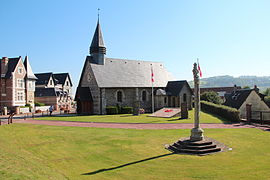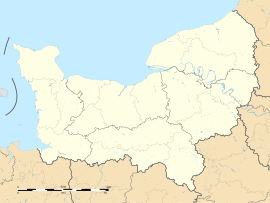world.wikisort.org - France
Hautot-sur-Mer (French pronunciation: [oto syʁ mɛʁ], literally Hautot on Sea) is a commune in the Seine-Maritime department in the Normandy region in north-western France.
Hautot-sur-Mer | |
|---|---|
Commune | |
 The church of Pourville | |
 Coat of arms | |
Location of Hautot-sur-Mer  | |
 Hautot-sur-Mer  Hautot-sur-Mer | |
| Coordinates: 49°53′51″N 1°02′05″E | |
| Country | France |
| Region | Normandy |
| Department | Seine-Maritime |
| Arrondissement | Dieppe |
| Canton | Dieppe-1 |
| Intercommunality | CA de la Région Dieppoise |
| Government | |
| • Mayor (2020–2026) | Jean-Jacques Brument[1] |
| Area 1 | 9.46 km2 (3.65 sq mi) |
| Population | 1,891 |
| • Density | 200/km2 (520/sq mi) |
| Time zone | UTC+01:00 (CET) |
| • Summer (DST) | UTC+02:00 (CEST) |
| INSEE/Postal code | 76349 /76550 |
| Elevation | 0–103 m (0–338 ft) (avg. 90 m or 300 ft) |
| 1 French Land Register data, which excludes lakes, ponds, glaciers > 1 km2 (0.386 sq mi or 247 acres) and river estuaries. | |
Geography
A small town of farming and light industry situated in the Pays de Caux, immediately to the west of Dieppe, at the junction of the D 75, D 56 and D 925 roads. The chalk cliffs and pebble beach of the commune look out over the English Channel. The river Scie flows through the commune and to the sea at the small tourist resort of Pourville.
History
The commune was formed in 1822 by the joining together of the communes of Hautot ("Hotot" in 1240), Petit-Appeville and Pourville, on the coast. It was here that a large force of Canadian soldiers came ashore during the ill-fated Dieppe Raid on 19 August 1942.
Heraldry
 |
The arms of Hautot-sur-Mer are blazoned : Vert, a chief argent, overall a lion Or.
|
Population
|
| ||||||||||||||||||||||||||||||||||||||||||||||||||||||||||||||||||||||||||||||||||||||||||||||||||||||||||||||||||
| Source: EHESS[3] and INSEE (1968-2017)[4] | |||||||||||||||||||||||||||||||||||||||||||||||||||||||||||||||||||||||||||||||||||||||||||||||||||||||||||||||||||
Places of interest


- A nineteenth century château
- The ruins of a feudal castle
- A memorial to the World War II raid
- The two churches of St.Remi, both dating from the sixteenth century
- The modern church at Petit-Appeville
- Two 16th-century stone crosses
See also
References
- "Répertoire national des élus: les maires". data.gouv.fr, Plateforme ouverte des données publiques françaises (in French). 2 December 2020.
- "Populations légales 2019". The National Institute of Statistics and Economic Studies. 29 December 2021.
- Des villages de Cassini aux communes d'aujourd'hui: Commune data sheet Hautot-sur-Mer, EHESS. (in French)
- Population en historique depuis 1968, INSEE
Другой контент может иметь иную лицензию. Перед использованием материалов сайта WikiSort.org внимательно изучите правила лицензирования конкретных элементов наполнения сайта.
WikiSort.org - проект по пересортировке и дополнению контента Википедии